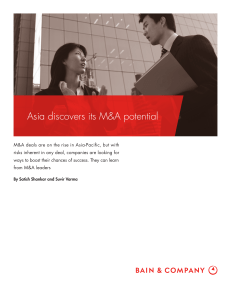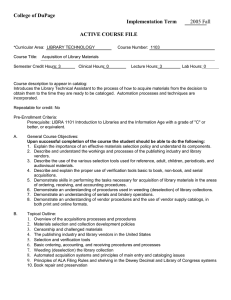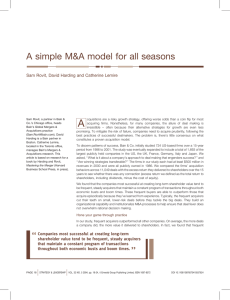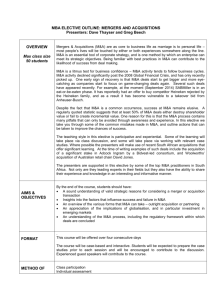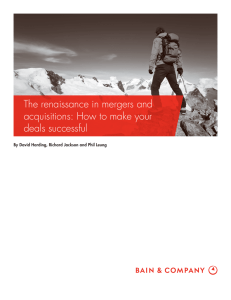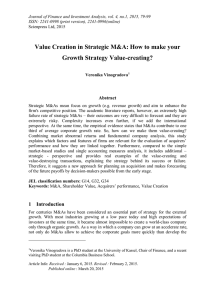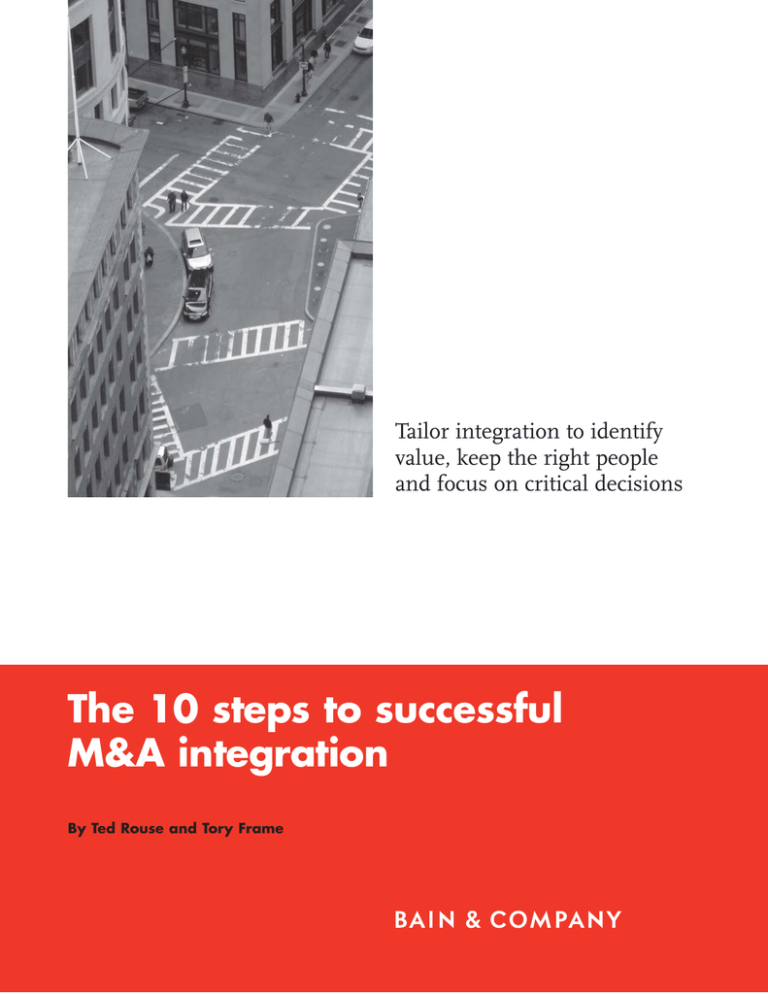
Tailor integration to identify
value, keep the right people
and focus on critical decisions
The 10 steps to successful
M&A integration
By Ted Rouse and Tory Frame
Ted Rouse is a partner with Bain & Company in Chicago and co-leader of Bain’s
Global M&A practice. Tory Frame is a partner in London and leader of London’s
Post-Merger Integration and Consumer Products practices.
Copyright © 2009 Bain & Company, Inc. All rights reserved.
Content: Editorial team
Layout: Global Design
The 10 steps to successful M&A integration
Tailor integration to
identify value, keep the
right people and focus
on critical decisions
Despite these successes, many acquirers—
perhaps most—leave huge amounts of value
on the table in every deal. Companies continue to stumble in three broad areas of postmerger integration:
•
Missed targets. Companies fail to define
clearly and succinctly the deal’s primary
sources of value and its key risks, so they
don’t set clear priorities for integration.
Some acquirers seem to expect the target
company’s people to integrate themselves.
Others do have an integration program
office, but they don’t get it up and running
until the deal closes. Still others mismanage
the transition to line management when
the integration is supposedly complete,
or fail to embed the synergy targets in the
business unit’s budget. All these difficulties are likely to lead to missed targets—
or an inability to determine whether
the targets have been hit or not.
•
Loss of key people. Many companies wait
too long to put new organizational structures and leadership in place; in the
meantime, talented executives leave for
greener pastures. Companies also may
fail to address cultural matters—the “soft”
issues that often determine how people
feel about the new environment. Again,
talented people drift away.
•
Poor performance in the base business. In
some cases, integration soaks up too much
energy and attention or simply drags on
too long, distracting managers from the
core business. In others, uncoordinated
actions or poorly managed systems migrations lead to active interference with the
base business—for example, multiple
(and contradictory) communications with
customers. Competitors take advantage
of such confusion.
Mergers and acquisitions—well conceived and
properly executed—can deliver greater value
than ever right now. And savvy acquirers are
taking action, as deal activity accelerates
amid signs of recovery.
One reason is the effect that a downturn has
on asset values: Other things being equal, it’s
a good time to buy. Bain analysis of more than
24,000 transactions between 1996 and 2006
shows that acquisitions completed during or
just after the 2001–2002 recession generated
almost triple the excess returns of acquisitions
made during the preceding boom years. (“Excess
returns” refers to shareholder returns from
four weeks before to four weeks after the deal,
compared with peers.) This finding held true
regardless of industry or the size of the deal.
Given today’s relatively low equity values,
acquirers with cash to invest are likely to find
deals that produce similar returns.
A second reason: Many companies are getting
better at M&A. At the beginning of the period
from 1995 to 2005, about 50 percent of mergers
in the US underperformed their industry index.
By the end of the period, only about 30 percent
were underperforming. One explanation, based
on our experience, is that some companies
have learned to pursue deals closer to their
core business, which increases the odds of
success. They more frequently pay cash rather
than stock, which encourages better due diligence and more-realistic prices. The long-term
trend of more-frequent acquisitions has also
pushed companies to develop repeatable models
for successful integration and managers with
professional integration-management skills.
1
The 10 steps to successful M&A integration
Successful integration—the key to avoiding
the risks of a merger or acquisition and to
realizing its potential value—is always a challenge. And it is complicated by the simple fact
that no two deals should be integrated in the
same way, with the same priorities, or under
exactly the same timetable. But 10 essential
guidelines can make the task far more manageable and lead to the right outcome:
1. Follow the money
Every merger or acquisition needs a wellthought-out deal thesis—an objective explanation of how the deal enhances the company’s
core strategy. “This deal will give us privileged
access to attractive new customers and channels.” “This deal will take us to clear leadership
positions in our 10 priority markets.” A clear
deal thesis shows where the money is to be
made and where the risks are. It clarifies the
five to 10 most important sources of value—
and danger—and it points you in the direction
of the actions you must take to be successful.
It should be the focus of both the due diligence
on the deal and the subsequent integration. It
is the essential difference between a disciplined
and an undisciplined acquirer.
The integration taskforces are then structured
around the key sources of value. It is also
necessary to translate the deal thesis into tangible nonfinancial results that everyone in the
organization can understand and rally around—
for example, one salesforce or one order-tocash process. The teams naturally need to
understand the value for which they are accountable, and should be challenged to produce
their own bottom-up estimates of value right
from the start. That will allow you to update
your deal thesis continuously as you work
toward close and cutover—the handoff from
the integration team to frontline managers.
Frequent acquirers outperform in the long term
Annual excess return
(1987–2006)
4%
3.0
3
2
1.5
1.0
1
0.7
0.7
1–9
10–24
0
0.2
1
Inactive
25–39
40–99
100+
Number of acquisitions (1987–2006)
Note: Annual excess return is defined as a company’s annualized total shareholder return less its cost of equity (calculated using CAPM)
2
The 10 steps to successful M&A integration
2. Tailor your actions to the
nature of the deal
3. Resolve the power and
people issues quickly
Anyone undertaking a merger or acquisition
must be certain whether it is a scale deal—an
expansion in the same or highly overlapping
business—or a scope deal—an expansion into
a new market, product or channel (some deals,
of course, are a mix of the two types). The
answer to the scale-or-scope question affects a
host of subsequent decisions, including what
you choose to integrate and what you will keep
separate; what the organizational structure will
be; which people you retain; and how you manage the cultural integration process. Scale deals
are typically designed to achieve cost savings
and will usually generate relatively rapid
economic benefits. Scope deals are typically
designed to produce additional revenue. They
may take longer to realize their objectives,
because cross-selling and other paths to revenue
growth are often more challenging and timeconsuming than cost reduction. There are valid
reasons for doing both types of transactions—
though success rates in scope deals tend to be
lower—but it is critical to design the integration
program to the deal, not vice versa.
The new organization should be designed
around the deal thesis and the new vision for
the combined company. You’ll want to select
people from both organizations who are enthusiastic about this vision and can contribute the
most to it. Set yourself an ambitious deadline
for filling the top levels and stick to it—tough
people decisions only get harder with time.
Moreover, until you announce the appointments, your best customers and your best
employees will be actively poached by your
competitors when you are most vulnerable to
attack. The sooner you select the new leaders,
the quicker you can fill in the levels below them,
and the faster you can fight the flight of talent
and customers and the faster you can get on
with the integration. Delay only leads to endless corridor debate about who is going to stay
or go and spending time responding to headhunter calls. You want all this energy focused
on getting the greatest possible value out of
the deal.
Consider the recent spate of announcements
about computer hardware companies buying
services businesses. In 2008, it was HewlettPackard buying EDS. More recently, Dell
announced the acquisition of Perot Systems,
and Xerox made a bold move for ACS that will
more than double the size of its workforce.
These are clearly scope deals, as these companies search for ways to move up the value
chain into more profitable lines of business.
And they require a new type of integration
effort for these hardware companies. If HP,
for example, applied the same principles and
processes that it used in integrating Compaq,
it would greatly complicate the EDS acquisition.
The fallout from delays in crucial personnel
decisions is all too familiar. When GE Capital
agreed to buy Heller Financial in 2001, paying
a nearly 50 percent premium over Heller’s share
price at the time, GE Capital indicated that it
would need to reduce Heller’s workforce by
roughly 35 percent to make the deal viable. But
it didn’t move quickly to say who would remain.
Key players departed before waiting to find
out, and several helped Merrill Lynch create a
rival middle-market unit the following year.
4. Start integration when you
announce the deal
Ideally, the acquiring company should begin
planning the integration process even before
the deal is announced. Once it is announced,
3
The 10 steps to successful M&A integration
there are several priorities that must be immediately addressed. Identify everything that must
be done prior to close. Make as many of the
major decisions as you can, so that you can
move quickly once close day arrives. Get the
top-level organization and people in place fast,
as we noted—but don’t do it so fast that you
lose objectivity or that you shortcut the
necessary processes.
One useful tool is a clean team—a group of
individuals operating under confidentiality
agreements and other legal protocols who can
review competitive data that would otherwise
be off limits to the acquirer’s employees. Their
work can help get things up to speed faster
once the deal closes. In late 2006, for example,
Travelport—owner of the Galileo global distribution system (GDS) for airline tickets—
announced that it intended to acquire Worldspan,
a rival GDS. The two companies used a clean
team to work through many critical people
and technology issues while they awaited
final regulatory approval from the European
Commission. When regulators gave the green
light, the company was able to begin integration immediately rather than spending weeks
waiting to gather the necessary data and making
critical decisions in a rush.
5. Manage the integration
through a “Decision Drumbeat”
Companies can create endless templates and
processes to manage an integration. But too
much program office bureaucracy and paperwork distract from the critical issues, suck the
energy out of the integration and demoralize
all concerned. The most effective integrations
instead employ a Decision Management Office
(DMO); and integration leaders, by contrast,
focus the steering group and taskforces on the
critical decisions that drive value. They lay out
a decision roadmap and manage the organization to a Decision Drumbeat to ensure that
4
each decision is made by the right people at the
right time with the best available information.
To get started, ask the integration taskforce
leaders to play back the financial and nonfinancial results they are accountable for, and
in what timeframe. That will help identify the
key decisions they must make to achieve these
results, by when and in what order. Using this
method, one global consumer products company recently was able to exceed its synergy
targets by 40 percent—faster than originally
planned—while retaining 75 percent of the top
talent identified. (For a primer on how companies can create an effective decision timeline,
see “Making it happen: The Decision Drumbeat
in practice,” on page 7.)
6. Handpick the leaders of the
integration team
An acquisition or merger needs a strong leader
for the Decision Management Office. He or
she must have the authority to make triage
decisions, coordinate taskforces and set the
pace. The individual chosen should be strong
on strategy and content, as well as process—
in other words, one of your rising stars. Ideally,
this individual and other taskforce leaders will
spend about 90 percent of their time on the
integration. Given the importance of maintaining the base business’s performance while
you’re pursuing integration, one solution is to
put the No. 2 person in a country or function
in charge of the integration taskforce. The
chief can take over the No. 2’s responsibilities
for the duration.
7. Commit to one culture
Every organization has its own culture—the set
of norms, values and assumptions that govern
how people act and interact every day. It’s “the
way we do things around here.” One of the
biggest challenges of nearly every acquisition
The 10 steps to successful M&A integration
or merger is determining what to do about
culture. Usually the acquirer wants to maintain
its own culture. Occasionally, it makes the
acquisition in hopes of infusing the target
company’s culture into its own. Whatever the
situation, commit to the culture you want to
see emerge from the integration, talk about it
and put it into practice. A diagnostic can help
reveal the gaps between the two, provided
acquirers are appropriately skeptical about
people’s descriptions of their organization’s
culture and provided they recognize their own
potential biases.
Whatever you decide on, executives from the
CEO on down then need to manage the culture
actively. Design compensation and benefits
systems to reward the behaviors you are trying
to encourage. Create an organizational structure
and decision-making principles that are consistent with the desired culture. The company’s
leaders should take every opportunity to role-
model the desired behaviors. And they should
consider carefully the fit with the new culture
in making decisions about which people to
keep. Will they support and reflect the new
culture—or not?
When Cargill Crop Nutrition acquired IMC
Global to form the Mosaic Company, a global
leader in the fertilizer business, the new CEO,
who came from Cargill, knew from the outset
that retaining IMC employees and creating one
culture would be important to the success of
the fledgling company. One-on-one meetings
with the top 20 executives and surveys of the
top teams from both companies revealed differences between Cargill’s consensus-driven
decision-making process—which would be the
culture of the new company—and IMC’s morestreamlined approach, which emphasized
speed. Armed with an early understanding of
the differences in approach, the CEO was able
to select leaders who reinforced the new culture.
The penalties are greatest for one-shot mega-deals or sitting on the sidelines
Annual excess returns (1987–2006)
Frequent
(More than or
equal to 0.5
deals per year)
“String of pearls”
1.87%
“Mountain climbers”
2.69%
“Small bets”
1.46%
“Roll the dice”
0.93%
Small
(Less than 9% of buyer’s market cap)
Large
(More than or equal to 9% of buyer’s market cap)
Acquisition
frequency
Infrequent
(Fewer than 0.5
deals per year)
“Inactives”
0.17%
Average acquisition size
Note: Undisclosed deals assumed at 3% (based on median of disclosed deals)
Source: Bain U.S. longterm acquirer performance study (2007)
5
The 10 steps to successful M&A integration
Cargill managers also made time to explain
the benefits of their decision-making system
to their new colleagues, rather than simply
mandating it. Result: The synergies estimated
(and owned) by jointly staffed integration teams
turned out to be double what due diligence
had estimated.
8. Win hearts and minds
Mergers and acquisitions make people on both
sides of the transaction nervous. They’re uncertain what the deal will mean. They wonder
whether—and how—they will fit into the
new organization. All of this means that you
have to “sell” the deal internally, not just to
shareholders and customers.
Consider the challenge faced by InBev, the global
beverage company, in acquiring Anheuser-Busch,
one of the most iconic American brands. Early
in the integration process, the leadership team
focused on the most effective way to introduce
InBev’s long-term global strategy to AnheuserBusch managers and employees. One powerful tool was InBev’s “Dream-People-Culture”
mission statement, which was tailored to the
US company and introduced into the AnheuserBusch lexicon with strong messages emphasizing the value of its customers and products,
to excite the imagination of the AB organization.
It’s vital that your messages be consistent. If
you are acquiring a smaller company and
the deal is mostly about taking out costs, for
instance, don’t focus on a “Best of Both Organizations” in your first town-hall speech. In
general, it’s wise to concentrate on what the
deal will mean in the future for your people,
not on the synergies it will produce for the
organization. “Synergies,” after all, usually
means reducing payroll, among other things—
and people know that.
6
9. Maintain momentum in the base
business of both companies—and
monitor their performance closely
It’s easy for people in an organization to get
caught up in the glamour of integrating two
organizations. For the moment, that’s where
the action is. The future shape of the company,
including jobs and careers, appears to be in
the hands of the integration taskforces. But if
management allows itself and the organization
to get distracted, the base business of both
companies will suffer. If everybody’s trying to
manage both the ongoing business and the
integration, nobody will do either job well.
The CEO must set the tone here. He or she
should allocate the majority of time to the base
business and maintain a focus on existing
customers. Below the CEO, at least 90 percent
of the organization should be focused on the
base business, and these people should have
clear targets and incentives to keep those businesses humming. By having No. 2s running
the integration, their bosses should be able to
make sure the base business maintains momentum. Take particular care to make customer
needs a priority and to bundle customer and
stakeholder communications, especially when
systems change and customers may be confused
about who to deal with. Meanwhile, establish
an aggressive integration timeline with a countdown to cutover—the day when the primary
objectives of integration are completed and
the two businesses begin operating as one.
To make sure things stay on track, monitor
the base business closely throughout the
integration process. Emphasize leading indicators like sales pipeline, employee retention
and call-center volume.
The 10 steps to successful M&A integration
Olam International, a global leader in the
agri-commodity supply chain business with
$6 billion in annual revenues, has managed
to maintain its base business while incorporating a stream of acquisitions. In 2007, for
instance, Olam purchased Queensland Cotton,
with trading, warehousing and ginning operations in the US, Australia and Brazil. Olam
ensured that a core part of the Queensland
Cotton team remained focused on the base
business, while putting together a separate
team made up of Queensland Cotton and Olam
employees to manage the integration. That
helped the company navigate difficult conditions due to drought in Australia, while also
growing their Brazil and US businesses well
above the market. Olam’s acquisitions contributed 16 percent to its total sales volumes
in fiscal year 2009 and 23 percent to its earnings, which have grown at an overall rate of
45 percent CAGR since 1990.
10. Invest to build a repeatable
integration model
Once you have achieved integration, take the
time to review the process. Evaluate how well
it worked and what you would do differently
next time. Get the playbook and the names of
your integration experts down on paper, so that
next time you will be able to do it better and
faster—and you will be able to realize that
much more value from a merger or acquisition.
Bain has done extensive research on what
drives success in acquisitions, including two
Learning Curve studies completed in 2004
and again in 2007. The data is compelling.
Frequent acquirers consistently outperform
infrequent acquirers as well as companies that
do no deals at all. If you had invested $1 in each
group, the returns from the frequent-acquirer
group would be 25 percent greater than the
infrequent group over a 20-year period. Over
the last 15 years, a number of companies,
including Cisco Systems, Danaher, Cardinal
Health, Olam International and ITW, have
shown that you can substantially beat the odds
if you get the integration process right and
make it a core competency.
Making it happen: The Decision
Drumbeat in practice
A Decision Drumbeat is the way to focus your
senior management and integration taskforces
quickly on the critical decisions necessary for
a merger integration to succeed. Here’s how
one global consumer products company applied
this approach to sucessfully integrate a major
competitor in record time:
Focus on the fundamentals. The first rule is to
clearly articulate the financial and non-financial
results you expect, and by when. Parcel out
these results to each of the integration taskforces, and have them work out the decisions
necessary to get there. Pare these decisions
down to the bare essentials—just what’s necessary to deliver one integrated company on
schedule. It’s important to distinguish between
integration and optimization decisions. The
latter should be put off until the integration
is complete.
For the consumer products company, it was
imperative to quickly equip the salesforce with
an integrated portfolio of brands for the busy
trading period, despite the fact that some of the
brands were aimed at the same consumers and
were positioned in similar ways. The answer
in this case was to quickly decide how to target
the brands at different outlets, and to leave
decisions about fundamental brand repositioning for later, after cutover to a single
combined company.
Coordinate decisions. Any integration involves
a large number of decisions in a short time
frame, and many of those decisions are highly
interdependent. So the timing of decisions
7
The 10 steps to successful M&A integration
needs to be closely coordinated, and everyone
needs to understand the impact their actions
have on others. For instance, most marketing
teams would prefer to wait until the end of the
integration process to recommend the final
product portfolio. Recognizing this tendency,
the consumer products company quickly made
a decision on the brand portfolio. That set up
a series of cascading decisions: Within four
weeks, the company had created new SKU
lists, order forms and sales scripts, and had
trained the salesforce so that they were able
to sell each brand when they hit the streets
representing the combined company. The
Decision Management Office plays an important
coordinating role: first, by helping the taskforces
work out which decisions must be made to
deliver their results; second, by ensuring that
the decisions are made and executed in the
right order to support the decision deadlines of
other taskforces. No one else has the integrated
view of the timing and the value at stake.
Assign decision rights and roles. The Decision
Management Office should then map out who is
responsible for each decision and communicate
that to all involved. One of the most effective
ways to clarify decision roles, in our experience,
is a system we call RAPID—a loose acronym for
Recommend (which usually involves 80 percent
of the work); offer Input; Agree or sign off on
(limited to rare circumstances, for example,
when fiduciary responsibilities are involved);
Decide, with one person assigned the “D”; and
Perform, or execute the decision. The resulting
decision roadmap shows who is accountable
for each major decision and when that decision
needs to be taken.
At the consumer products company, the steering
group focused on the 20 percent of decisions
that were most critical to integration success,
leaving the remainder of the decisions to the
integration taskforces. That meant the integration
was able to move at maximum speed and, by
8
empowering the taskforce leaders, many gained
priceless management experience that led to
eventual promotions.
Stick to the timetable. Actively ensure that everyone is on track to make their decisions. The
Decision Management Office ensures that each
taskforce has what it needs from other taskforces or from the steering group to make their
decisions on time through the weekly drumbeat of meetings with each of the taskforces.
When necessary, bring in experts to speed up
team delivery; and bring teams together for
major decision points and cutover plans, which
require detailed and coordinated planning. Focus
your working sessions on critical trade-offs and
the additional work required to resolve them.
Here, again, the consumer products company
kept to the deadline by providing extra help to
the taskforces when they risked missing decision deadlines—to ensure union negotiators
had what they needed to secure agreement
from manufacturing employees, for instance,
or to work around obstacles in the distribution
system when containers from the two companies
did not fit on the same trucks. As one senior
executive later said: “We focused on decisions,
not on process for process’s sake. From day one
we had a focused plan that everyone understood
and believed in, and that really energized the team.”
As we emerge from the global recession, companies should prepare to take advantage of
attractive asset values and to capture the benefits
garnered by frequent acquirers. But they must
act with judgment and finesse. Winners in this
game will bring a tailored approach to integration, adjusting their approach to the deal
thesis with one eye constantly fixed on the
critical sources of value and risk. The most
experienced acquirers not only understand these
10 steps to a successful integration, they also
understand how to adjust their application to
the deal and the circumstances.
The 10 steps to successful M&A integration
Bain’s business is helping make companies more valuable.
Founded in 1973 on the principle that consultants must measure their success in terms
of their clients’ financial results, Bain works with top management teams to beat competitors
and generate substantial, lasting financial impact. Our clients have historically outperformed
the stock market by 4:1.
Who we work with
Our clients are typically bold, ambitious business leaders. They have the talent, the will
and the open-mindedness required to succeed. They are not satisfied with the status quo.
What we do
We help companies find where to make their money, make more of it faster and sustain
its growth longer. We help management make the big decisions: on strategy, operations,
technology, mergers and acquisitions and organization. Where appropriate, we work with
them to make it happen.
How we do it
We realize that helping an organization change requires more than just a recommendation.
So we try to put ourselves in our clients’ shoes and focus on practical actions.
For more information, please visit www.bain.com


